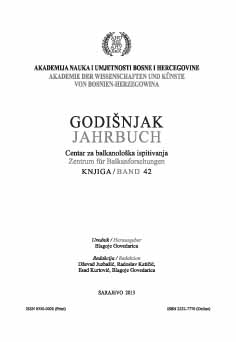Pedeset godina Centra za balkanološka ispitivanja Akademije nauka i umjetnosti Bosne i Hercegovine
Fifty years of the Centre for Balkan Studies of the Academy of Sciences and Arts of Bosnia and Herzegovina
Author(s): Blagoje GovedaricaSubject(s): Archaeology
Published by: Akademija Nauka i Umjetnosti Bosne i Hercegovine
Summary/Abstract: Balkanology has long tradition in Bosnia and Herzegovina. Beginnings and development of balkanology are closely linked to the strong wave of Europeanization and modernization of the entire life that flooded this area with the arrival of Austro-Hungarian rule in the late 19th century. Institute for Balkan research founded already in 1904 by the visionary Karl Patsch is the first institution of this kind in Southeast Europe. Although it was not long-lived, the activity of the Institute, in particular continuous activity of its parent organization, the National Museum, have greatly contributed that Sarajevo became an important centre of new research ideas and aspirations in the region. The emergence of the Centre for Balkan Studies of the Academy of Sciences and Arts of Bosnia and Herzegovina should be considered in this context. The establishment of this institution in 1963 was a major innovation in the field of balkanology, but this certainly would not have happened if there was not a long and valuable experience from the previous period. The Centre for Balkan Studies from the beginning conceived as an interdisciplinary institution that deals with the study and presentation of the cultural history of the Balkans, from prehistory to the modern age. The Centre’s full organizational structure consists of a working core in the Academy of Sciences and Arts of Bosnia and Herzegovina, specialists from the balkanology disciplines – director and regular members, leading scientists in the domain of archaeology, history, linguistics, ethnology and anthropology, from different institutions of former Yugoslavia, Balkans and Europe. Thanks to this organization Centre was able to activate eminent associates not only in the local context, but also to a far wider area. Scientific programs are designed and carried out in cooperation of the working core and the members, which ensures systematic interdisciplinary communication and reaches a high level and broad scope of scientific work. The main activity of the Centre is carried out within the scientific research projects that involve field research, creating the documentation’s centres, organization of scientific meetings and publications that present results of those activities to scientific and wider public. So far, six extensive field research in Bosnia and Herzegovina, Croatia and Serbia were conducted, 17 thematic meetings and conferences were held, 41 volume of Godišnjak with 559 articles and contributions, 24 special editions and monographs, and 5-volume edition Prehistory of Yugoslav Countries were published, while Spiritual culture Illyrians cartulary was created and prepared for digitalization. About these activities will be further discussed in the entitled article.
Journal: Godišnjak Centra za balkanološka ispitivanja
- Issue Year: 2013
- Issue No: 42
- Page Range: 9-21
- Page Count: 13
- Language: Bosnian

